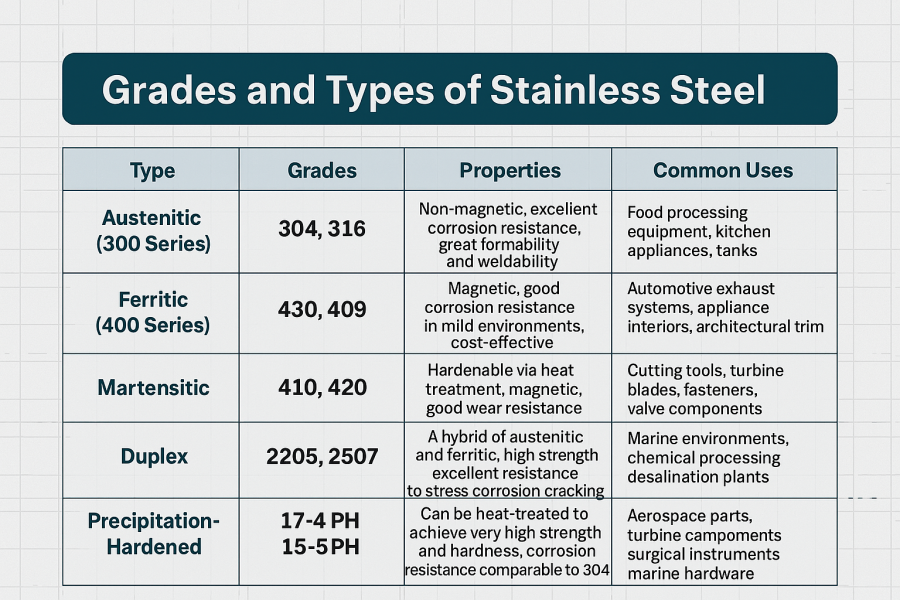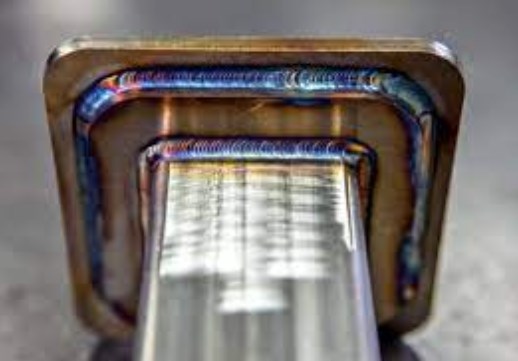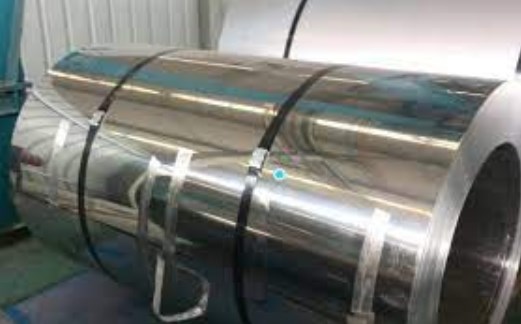Stainless steel refers to steel that has chromium mixed into it to put it in a passivated state, thus possessing properties that resist rusting. To achieve this, the chromium content must be at least 12%. Additionally, to further enhance the steel's corrosion resistance, elements such as nickel and molybdenum are often added to promote passivation.
Generally, the term "stainless steel" actually refers to both stainless steel and acid-resistant steel. Stainless steel doesn't necessarily have acid resistance, while acid-resistant steel typically exhibits good anti-rust properties.
I. Stainless Steel Types and Their Characteristics:
Based on different steel structures, stainless steel can be divided into four types: austenitic stainless steel, ferritic stainless steel, martensitic stainless steel, and duplex stainless steel.

1)Austenitic Stainless Steel and Its Welding Characteristics:
Austenitic stainless steel is a type of stainless steel with a high proportion of chromium and nickel, typically being pure austenite in structure at room temperature. This steel has good plasticity, toughness, and excellent corrosion resistance. During welding, austenitic stainless steel has the following characteristics:
Intergranular corrosion: Austenitic stainless steel may precipitate Cr23C6 carbides at grain boundaries when held in the temperature range of 450℃ to 850℃ for a certain period, leading to the formation of chromium-depleted zones and causing intergranular corrosion. Measures to prevent intergranular corrosion include using ultra-low carbon or adding stabilizing elements (such as titanium or niobium) in the welding material, adopting small specification welding, and performing post-weld solution treatment.
Hot cracking: Due to the high coefficient of expansion of austenitic stainless steel, significant shrinkage stresses can occur during cooling, making it prone to hot cracking. To control hot cracking, the welding seam's metal structure can be controlled to exhibit a duplex structure, with ferrite content controlled below 3% to 5%, and by selecting appropriate electrode coatings.
Stress corrosion cracking: Austenitic stainless steel welded joints may experience delayed cracking under specific corrosive environments when subjected to tensile stress. Measures to prevent stress corrosion cracking include selecting suitable welding materials, ensuring good matching between the weld and base metal, adopting appropriate welding processes, and performing post-weld stress relief treatment.
Poor weld bead formation: During the welding of austenitic stainless steel, the high alloy element content in the weld seam can result in poor weld bead formation on the surface. Preventive measures include using tungsten inert gas (TIG) welding for root passes, controlling the sensitization temperature range of the heat-affected zone, and employing narrow bead welding techniques.

2)Ferritic Stainless Steel and Its Welding Characteristics:
Ferritic stainless steel contains 10.5% to 30% chromium, with a body-centered cubic crystal structure. This type of steel usually does not contain nickel but may sometimes have small amounts of elements like molybdenum, titanium, or niobium added. It has a high thermal conductivity, low coefficient of expansion, and exhibits good oxidation resistance and stress corrosion resistance. In terms of welding, ferritic stainless steel has the following characteristics:
Weldability: Due to the low coefficient of thermal expansion of ferritic stainless steel, welding can easily induce welding stress, which may lead to cracking. Therefore, preheating before welding and gradual cooling after welding is crucial.
Intergranular corrosion: Ferritic stainless steel may undergo intergranular corrosion during welding, especially when the carbon content is high. To reduce intergranular corrosion, low-carbon or stabilized welding materials can be chosen.
Corrosion resistance: The corrosion resistance of ferritic stainless steel is superior to that of austenitic 316 stainless steel, especially in environments with high chlorine content.
Mechanical properties: The yield strength and tensile strength of ferritic stainless steel are slightly higher than those of low-carbon steel, but its ductility is lower. Therefore, attention should be paid to the plasticity and toughness of the weld seam during welding.
Brittleness: Ferritic stainless steel may exhibit brittleness at room temperature, especially high-chromium ferritic stainless steel. This issue can be improved by controlling the cooling rate during welding and subsequent heat treatment.
High-temperature embrittlement: At high temperatures, ferritic stainless steel may undergo high-temperature embrittlement, which is related to the precipitation of carbides at high temperatures. Controlling the carbon and nitrogen content in the steel can reduce the risk of high-temperature embrittlement.

3)Martensitic Stainless Steel and Its Welding Characteristics:
Martensitic stainless steel is a high-carbon stainless steel with a body-centered cubic crystal structure. It can achieve high strength and hardness through heat treatment, but, in contrast, it has lower plasticity and toughness. Regarding welding, martensitic stainless steel has the following characteristics:
Quenching tendency: Martensitic stainless steel is prone to forming a hard and brittle martensite structure during welding cooling, increasing the risk of brittleness and cracking of the welded joint.
Preheating and post-heat treatment: To reduce welding stress and prevent cracking, proper preheating of martensitic stainless steel before welding and subsequent post-weld heat treatment to restore the toughness of the weld area are essential.
Welding cracks: Due to the hardening characteristics and welding stress of martensitic stainless steel, welded joints are prone to cold cracks, especially without proper preheating and post-heat treatment.
Welding material selection: Choosing the right welding material is crucial. Typically, low-hydrogen electrodes or wires matching the chemical composition of the base metal are used to reduce the risk of cracks.
Welding process: To achieve good welding quality, suitable welding processes such as arc welding and tungsten inert gas (TIG) welding should be selected, and welding parameters should be strictly controlled.
Cooling rate: The cooling rate after welding has a significant impact on the welding quality of martensitic stainless steel. Too fast cooling increases the risk of hardening and cracking, while too slow cooling may reduce the toughness of the welded area.
II. Selection of Stainless Steel Welding Materials for Pressure Vessels:
1)Selection of Austenitic Stainless Steel Welding Materials:
When selecting welding materials for austenitic stainless steel, several principles can be followed:
Match with the base metal: First, choose welding materials that match the chemical composition of the base metal. For example, when welding 310 or 316 stainless steel, select corresponding welding materials.
Consider the welding environment: If there are corrosive media in the welding environment, choose welding materials that can resist that specific medium. For instance, in environments containing dilute sulfuric acid or hydrochloric acid, select stainless steel welding materials containing Mo or Mo and Cu.
Working under low-temperature conditions: If austenitic stainless steel operates under low-temperature conditions, ensure that the welded joint has good low-temperature impact toughness. In this case, pure austenitic welding materials such as A402 or A407 can be used.
Welding different types of steel: When welding different types of steel, such as carbon steel and stainless steel, choose welding materials with higher alloy content to balance the dilution rate in the weld.
Post-welding treatment: Consider whether post-weld heat treatment is required after welding to prevent issues like intergranular corrosion.
2)Selection of Ferritic Stainless Steel Welding Materials:
When selecting welding materials for ferritic stainless steel, the following factors should be considered:
Match with the base metal: Choose welding materials with similar chemical compositions to the base metal to ensure good compatibility and mechanical properties.
Welding Condition Restrictions: If preheating before welding is not feasible or post-weld heat treatment is difficult, consider using austenitic stainless steel welding materials with higher alloy content.
Welding Dissimilar Materials: When welding dissimilar base metals, such as carbon steel and stainless steel, where one contains alloying elements and the other does not, use welding filler materials with higher alloy content to balance the dilution rate in the weld joint.
Consideration of Welding Environment: If corrosive media are present in the welding environment, select welding materials capable of resisting those specific media. For instance, for media containing dilute sulfuric acid or hydrochloric acid, stainless steel welding materials containing Mo or Mo and Cu are typically chosen.
Availability of Welding Materials: In practical applications, the availability and cost-effectiveness of welding materials also need to be considered.
3)Selection of Martensitic Stainless Steel Welding Materials:
When selecting welding materials for martensitic stainless steel, it's necessary to consider the specific application and working environment. Here are some guiding principles:
Matching with the base metal: First, choose welding materials that match the chemical composition of the base metal. For example, when welding martensitic stainless steel, you can choose chromium stainless steel electrodes or chromium-nickel austenitic stainless steel electrodes.
Consider the working environment: If there are corrosive media in the welding environment, select welding materials that can resist that specific medium. For example, in environments containing dilute sulfuric acid or hydrochloric acid, stainless steel electrodes containing Mo or Mo and Cu are typically chosen.
Welding performance: Martensitic stainless steel welding joints generally have good strength and toughness and typically do not require preheating before welding or post-weld heat treatment.
III. Key Points for Welding Stainless Steel for Pressure Vessels:
1)Key Points for Welding Austenitic Stainless Steel:
Intergranular corrosion: Intergranular corrosion is the most dangerous form of damage for austenitic stainless steel. To prevent intergranular corrosion, the following measures can be taken: A) Use ultra-low carbon (C ≤ 0.03%) or stainless steel electrodes containing stabilizing elements such as titanium or niobium. B) Use small specifications, reduce the time spent at dangerous temperatures, use low currents, and weld quickly to avoid lateral oscillation. C) Force-cool the weld seam to increase the cooling rate and reduce the heat-affected zone.
Hot cracking: To prevent hot cracking, control the weld metal structure to achieve a duplex structure and keep the ferrite content below 3% to 5%.
Stress corrosion cracking: Stress corrosion cracking is a delayed cracking phenomenon that occurs in welded joints under specific corrosive environments subjected to tensile stress. Reasonable forming and assembly processes should be established, and appropriate welding processes such as post-weld solution treatment should be adopted.
Poor weld bead formation: Poor weld bead formation during the welding of austenitic stainless steel may affect its low-temperature performance. Narrow bead welding techniques, controlled welding speeds, and good fusion should be utilized to address this issue.
2)Key Points for Welding Ferritic Stainless Steel:
Selection of appropriate filler metal: Choose filler metals with nickel content slightly higher than that of the base metal to prevent cracking and reduce corrosion resistance.
Control of heat input: Excessive heat input can cause deformation and cracking during welding. Therefore, minimize heat input as much as possible, and keep interpass temperature below 100°C during multi-pass welding.
Protection of the weld pool: Special attention should be paid to protecting the weld pool of ferritic stainless steel to prevent surface contamination. This can be achieved by increasing weld pool protection, such as using double-layer gas protection, increasing nozzle diameter, adjusting argon flow rate, or adding a protective gas shield behind the welding torch.
Treatment of welded joints: Welded joints of ferritic stainless steel may experience intergranular corrosion and embrittlement. Proper heat treatment can improve these issues.
3)Key Points for Welding Martensitic Stainless Steel:
Pre-weld cleaning: Thoroughly clean the groove and both sides to remove impurities such as oil and moisture, reducing the source of hydrogen.
Drying of electrodes: Preheat electrodes before welding at high temperatures to remove moisture and reduce sensitivity to cold cracking.
Selection of preheating temperature: The preheating temperature should be below the martensite transformation temperature, typically ranging from 150-400°C.
IV. Welding of Duplex Stainless Steel:
1)Types of Duplex Stainless Steel:
Duplex stainless steel (DSS) is a special type of stainless steel composed of approximately 50% ferrite and 50% austenite. This type of steel combines the advantages of both ferritic and austenitic stainless steels, with high strength, good plasticity, corrosion resistance, and welding performance. According to chemical composition and performance characteristics, duplex stainless steel can be classified into low-alloy, medium-alloy, high-alloy, and super duplex stainless steel types.
2)Welding Characteristics of Duplex Stainless Steel:
Good welding performance: Duplex stainless steel combines the advantages of both ferritic and austenitic stainless steels and is less prone to hot cracking and embrittlement during welding.
Control of the heat-affected zone: The selection of welding parameters is particularly important for the welding of duplex stainless steel, as it directly affects the proportion of ferrite in the weld metal. Too small heat input may generate excess ferrite in the weld metal, while too large heat input may cause the ferrite grains in the heat-affected zone to grow, reducing the mechanical properties of the welded joint.
Selection of welding materials: ER2209 or E2209 electrodes are usually recommended for welding duplex stainless steel, as they help achieve the optimal ratio of ferrite to austenite in the weld metal.
Use of shielding gas: The shielding gas is typically Ar+2%O2, which helps protect the weld from oxidation and contamination.
3)Selection of Duplex Stainless Steel Welding Materials:
Matching with the base metal: Generally, choose welding materials that match the chemical composition of the base metal. For example, for 2205 duplex stainless steel, ER2209 welding wire or E2209 welding rod is recommended.
Welding process: Select suitable welding processes, such as gas tungsten arc welding (GTAW) or gas metal arc welding (GMAW), and ensure proper shielding gas coverage to prevent oxidation.
Other considerations: factors such as corrosion resistance, mechanical properties and costs shall be considered based on specific applications.
4)Key Points for Welding Duplex Stainless Steel:
Matching of base metal and filler metal: Choose welding materials that match the chemical composition of the base metal. For example, for 2205 duplex stainless steel, ER2209 welding wire is recommended.
Welding process: Use suitable welding processes, such as gas tungsten arc welding (GTAW) with shielding gas. The recommended shielding gas is Ar+2%O2.
Selection of welding parameters: Welding parameters directly affect the proportion of ferrite in the welded metal. Avoid excessively low or high heat input to maintain a reasonable proportion of ferrite and austenite in the weld and heat-affected zone.
Preheating and interpass temperature control: Determine the need for preheating based on ambient temperature. During multi-pass welding, control interpass temperature to prevent grain coarsening and widening of the heat-affected zone.
Post-weld treatment: After welding, perform appropriate heat treatment as required to optimize the mechanical properties and corrosion resistance of the weld.
Non-destructive testing: Conduct necessary non-destructive testing, such as penetrant testing and ferrite content determination, to ensure welding quality.
V. Conclusion:
In discussing the welding of stainless steel, we have learned that material selection, welding techniques, choice of welding materials, and post-weld treatment are all critical factors in ensuring welding quality and performance. Whether it's austenitic, ferritic, martensitic, or duplex stainless steel, each material has its unique welding requirements and challenges. By accurately controlling welding parameters and adopting appropriate welding techniques, the performance of stainless steel can be maximized, ensuring the safety and reliability of machinery under extreme conditions. In summary, a deep understanding of the welding characteristics of stainless steel and the applicable welding methods is crucial for designing and manufacturing long-lasting machinery.
Related articles:
1. How can we weld stainless steel without causing it to burn?
2. Welding Stainless Steel Guide: Welding Processes & Welding Tips
3. Pulsed MIG Welding Aluminum and Stainless Steel
4. Why Does Stainless Steel Rust After Welding?
5. Stainless Steel Welding: What is it, Benefits, & Methods






